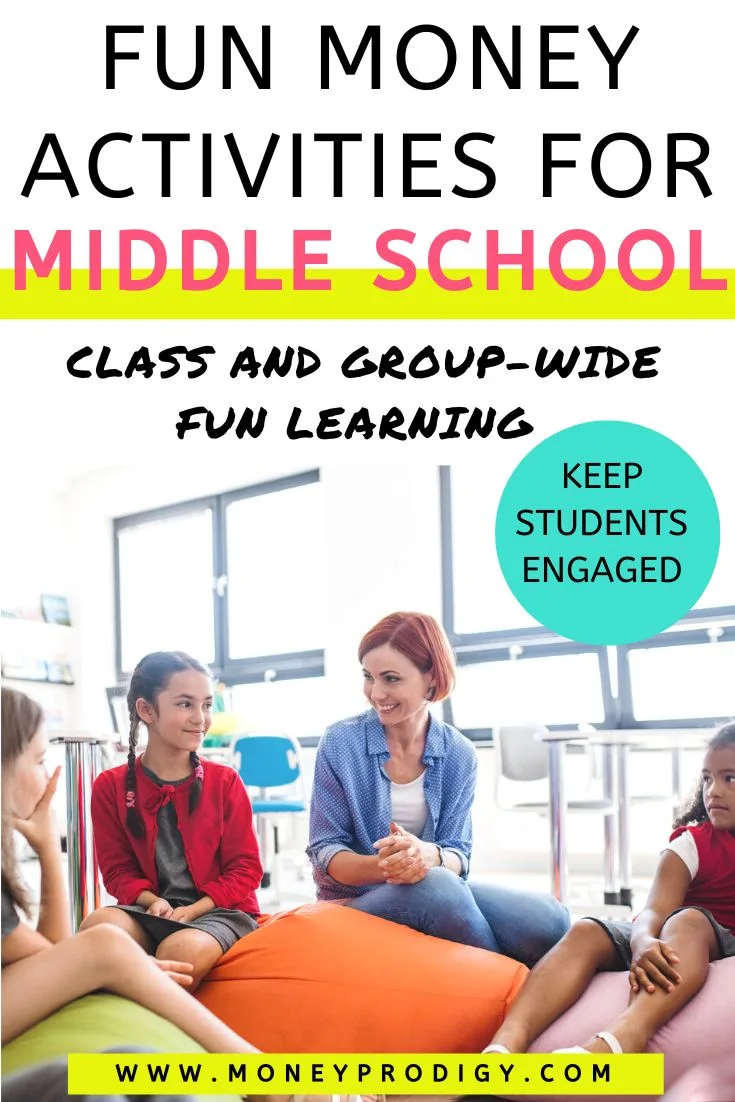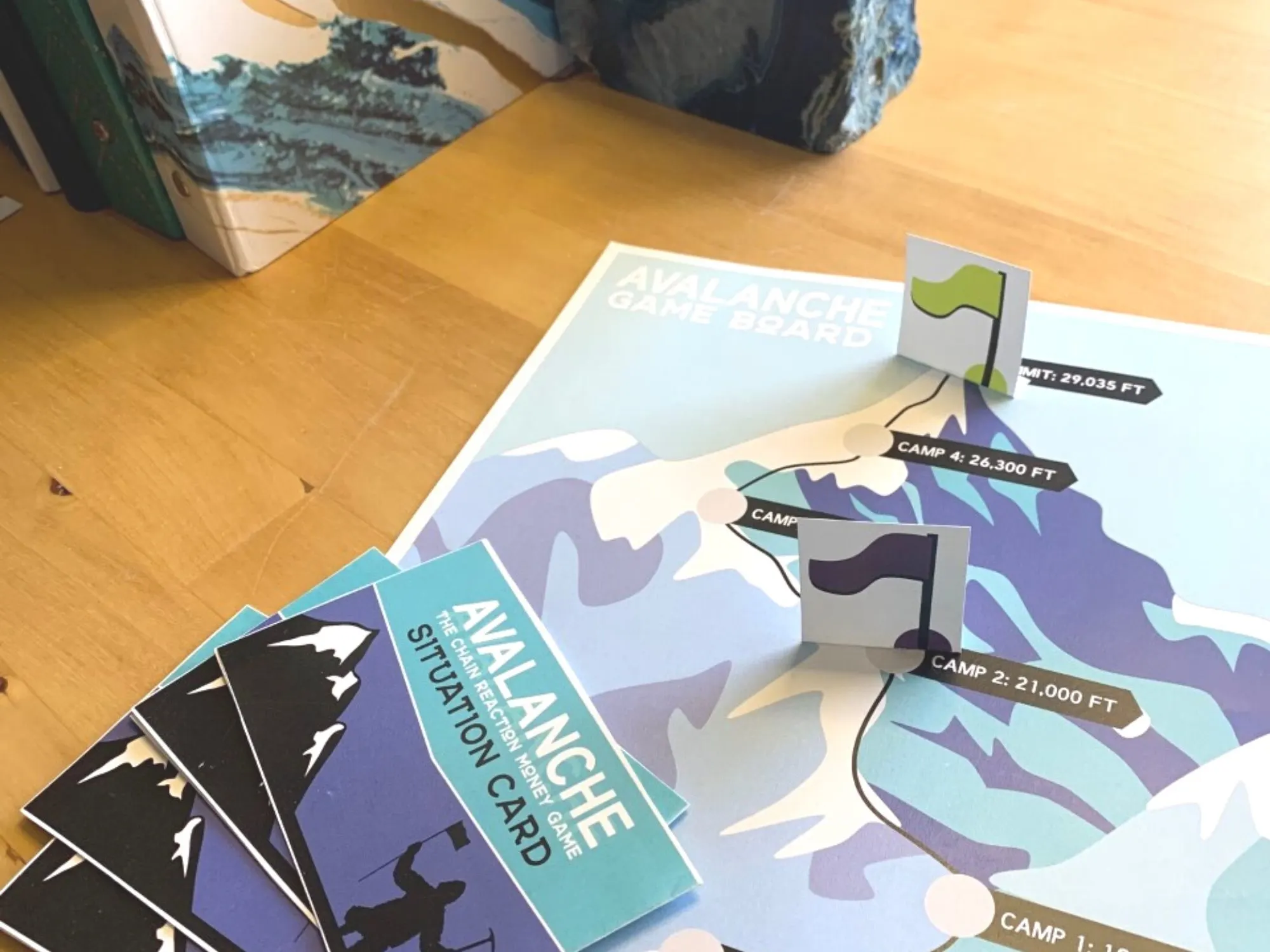Tasked to teach kids about money? These fun money activities for middle school students will keep them engaged and learning.
Looking for fun money activities for middle school students – you know, the kind they’ll beg you to do again, and again, and again?

I hear you. Getting students engaged is half the battle (who am I kidding…it’s probably 80% of the battle) when it comes to teaching middle schoolers about money.
And finding that perfect, engaging activity can make all the difference – I don’t know about you, but when I hear students blurt out money aha’s during one of the Everest Money Simulations I’ve run, it’s given me the chills.
That’s why I put together this list of fun money activities and games your students are sure to love and get a lot from.
Fun Money Activities for Middle School Students
Engaging your students is the name of the game.
Pick and choose from this list below – and let us know in the comments which ones your students couldn’t get enough of!
Psst: you’ll also want to check out my budget projects for middle school and fun budgeting activities.
1. Play Avalanche: The Money Decision Game
One of the things I noticed about kid money activities is there’s a lack of built-in natural consequences for decisions that kids are put in charge of making.
And let’s be honest: all decisions – especially money ones – affect your decision-making ability in the future. Good money decisions can expand your options in the future, and bad money decisions can limit your options to work from.
That’s why I created the Avalanche Money Decision Game.
It’s a fun, group money activity where students are tasked with making decisions on how to spend the remaining $20,000 to get ready to summit Everest.
Psst: it’s the shorter version of my full Everest Money Simulation.
As students draw situation cards and work through them based on the money decisions they made at the beginning. Periodic avalanches get triggered, depending on how they handle the situations.
The goal is to get 50% of the team’s players to the summit to “win”.
2. Play a Competitive Classroom Money Game
A little (friendly) competition can be a great tool to keep students engaged, right?
Cashy is a free online game where students compete against one another to be the richest AND the happiest, by the end of the game.
All students start with $2,000, and 80% happiness. Throughout the game, they need to work on growing their money and staying happy.
They’ll be tasked with creating and maintaining a monthly budget, earning income, and investing. Over a 10-year period (playtime is around 40 minutes), they can do things like decreasing spending (which can change their happiness level), starting a side hustle, increasing spending in certain categories, etc.
There’s a leaderboard to keep track of everything.
3. Play The Price is Right Grocery Game
Something that I hear about often is how kids don’t understand the cost of things.
Either, literally, they don’t know what a tube of toothpaste costs, AND/OR, how much things cost in relation to a “typical” income someone earns.
One way to help this is by playing a round of Price is Right with your group.
Hint: these free printables are geared towards a group date night, but you can definitely still use them with a group of students.
You’ll need to research the price of certain grocery store items the next time you’re in the store or online. Then, break your students up into groups and have each group fill out what they think the cost is for each item on the sheet.
Then, you can reveal the real numbers.
What surprised your students most? What did they guess correctly?
Should be a fun, engaging experience.
4. Play a Round of Island Adventure
Teaching your kids needs vs. wants?
Imagine setting the scene for your middle school students to be stranded on a deserted island. They then need to use this free worksheet to figure out what is a need, and what is a want (because they can only choose 4 things to bring with them).
That’s Island Adventure.
Hint: there are situation cards as well, which either throw a wrench into a group’s plans, or throws them a lifeline.
The class then comes back together and assesses which group is most likely to survive, based on what they decided to bring with them.
Also, here’s more Needs Vs. Wants worksheets, and my curated list of free financial literacy movies for students that could pair well with them.
5. Go Through these Money Conversation Starters
I’ve got a free set of money conversation starters are perfect for middle school students (so are these Would You Rather Money questions for middle schoolers).
Think of all the fun you guys can have hearing kids’ answers to questions like:
- What’s one belonging you’d like to keep forever because you think it’ll be worth money one day?
- By the time you’re your parents' age, how much money do you think you’ll be making?
- A space alien just landed in your backyard and wants to understand what money is. How do you explain it to them?
Hint: these can also be used as money journal topics for kids.
6. Host a 30-day Bill Pay Project
There aren’t that many activities out there for how to teach kids to budget…which is why I created this classroom budget pay simulation project.
Each student gets a job (either a horse trainer, police officer, web developer, or forensic scientist), an income, and a set of bills they have to pay by specific dates. One student is chosen as the banker, and there are specific banking hours.
Over the course of 30 days, students will:
- Get paid twice, according to their job token (plus $300 in starter money)
- Get a set of bills and a blank bill pay calendar for them to keep track of deadlines
- Get the chance to pay bills on time or ahead of time, when the bank is open
- Reflect on how the month went with reflection questions
Hint: does your crew need to learn about banking? Here are lots of free banking worksheet PDFs to help.
7. Make a Lego Construction Foreman Center
I detail this in my article on games to play with fake money, but in a nutshell:
- Come up with a Lego build project that must be completed (such as a house, a spaceship, a barn, etc.)
- Assign each type of Lego brick a different cost
- Give the group a budget of fake money they must stick to
How do the students decide to spend their budget? What does the end project look like, and what compromises/tweaks did they need to make to stay within budget?
Bonus: Start a Classroom Economy
Here are examples of classroom reward systems by real teachers, plus small prize ideas for students to get you started.
How do you teach middle schoolers about money? I hope I’ve helped answer that with these projects, activities, and games that will keep them engaged with the subject (which, as you well know, is 80% of the battle). Guide your students through these, and enjoy as your students share their self-discoveries about how money really works.
Amanda L. Grossman
Latest posts by Amanda L. Grossman (see all)
- 50 Banking Activities for Kids (Student Financial Literacy) - February 14, 2024
- 14 Christmas Activities for High School Students (they’ll Actually Find Cool) - December 1, 2023
- 3 Fun Selfie Scavenger Hunts for Teens (Christmas, Fin Lit, etc.) - November 27, 2023

